Using BIAN Service Landscape to Define and Organize Data Governance Artifacts
Biao Hao, Chief Technology Architect, US Financial Services Market, IBM Technology
Pat O’Sullivan, STSM, Knowledge Accelerators / Industry Models, IBM Software
Data plays a crucial role in many financial institutions’ success, helping them provide better customer experience, identify and manage risks associated with financial transactions, investments, and customers, comply with regulatory requirements, and manage and optimize operations. Data governance aims to ensure that data is managed in a way that aligns with the organization’s objectives, complies with regulations and laws, meets the needs of stakeholders, and supports the organization’s business processes. Data governance includes such activities as data quality management, metadata management, classification, security, and lifecycle management.
In this article, we explore using the Banking Industry Architecture Network (BIAN) as the industry framework for data governance. More specifically, we focus on two aspects. The first is to use BIAN’s domain decomposition model to define a set of data governance artifacts to establish the relationship between the data assets and the business capabilities they support. This relationship allows the organization to fully understand what parts of their data management domain are related to corresponding aspects of their business operations. The second is to combine these artifacts with the lower-level ones in existing industry accelerators to enable automatic data discovery and cataloging.
We start with an overview of two distinct viewpoints of BIAN. Then we introduce the data catalog concept and tooling to illustrate the subsequent data governance artifacts. Finally, we use BIAN Service Landscape as a component business framework to define the category hierarchy for organizing data governance artifacts and the business terms for mapping data assets to the business service components they support. We also show how to combine BIAN-based business terms with low-level artifacts from an industry knowledge accelerator.
Two Distinct Views of BIAN
Banking Industry Architecture Network (BIAN) defines a component business blueprint for the banking industry. BIAN specifies a set of Service Domains, each as a discrete, non-overlapping, and elemental business capability responsible for handling the entire lifecycle of its business function. These Service Domains collectively cover all banking activities.
BIAN Service Landscape
The Service Landscape organizes all the service domains into groups based on large Business Areas and more narrowly defined Business Domains within these areas. Two prevailing reference layouts exist — the matrix and value chain layouts. The diagram below (Figure 1) shows the value chain layout. For more details about BIAN reference model, follow the link.
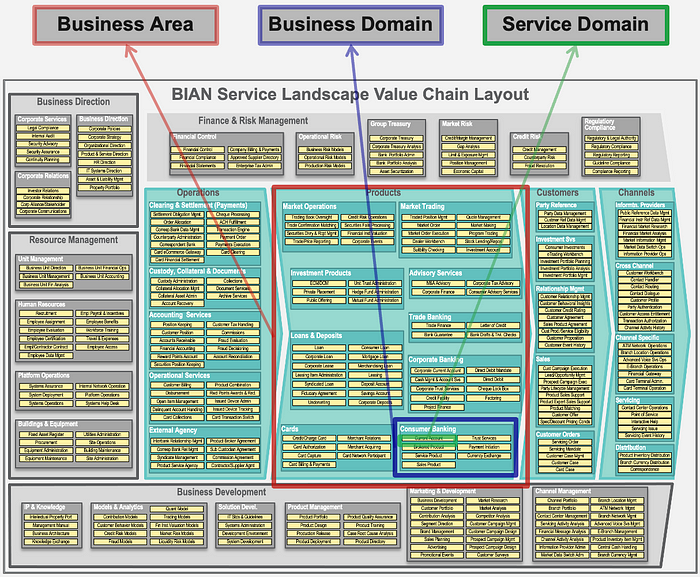
Organizations often customize the general BIAN Service Landscape to define the enterprise blueprints reflecting their management structure, lines of business, and specific products.
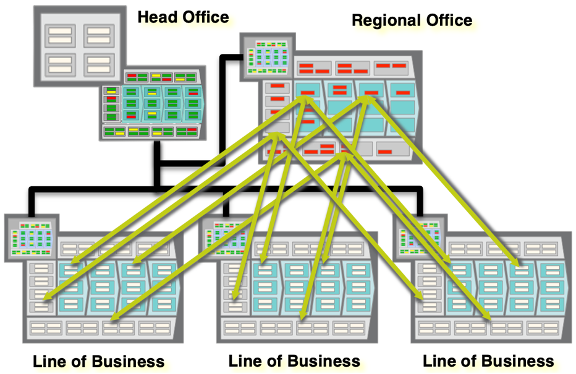
BIAN Business Capability Model (BCM)
BIAN also defined the BIAN Business Capability Model (BCM) as a collection of business capabilities and relevant value streams regarding what an organization does or wants to achieve. The primary purpose and value of BCM are in strategic planning that aligns business initiatives with business value. In other words, BCM aims to answer the questions of what makes it a viable business; and where to make critical investments by focusing on “what” and “why” a bank needs to be able to do something. More specifically, business capabilities define the “what” and value stream defines the “why”.
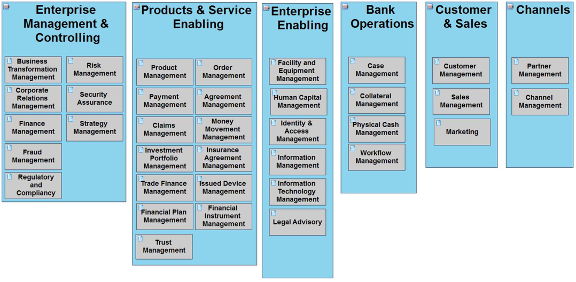
Service Landscape, on the other hand, is primarily defined as a set of discrete, elemental, non-overlapping, and fully encapsulated business operational functions uniquely assignable to a responsible organizational entity. The primary purpose and value in the service landscape viewpoint are to define and implement a set of functional capacities. In other words, what resources and functions are needed. They focus on “how” the business operates to provide value.
The combination of BCM and Service Landscape provides the opportunity to merge the business strategic insights and drivers from BCM with the implementation and delivery responsibility from the Service Landscape. Therefore, it is often desirable to correlate these two viewpoints. However, the relationship is often more complex than it sounds. In some cases, there is almost a one-to-one relationship between a business capability to a Service Domain, but in many cases, this relationship is many-to-many. A BIAN whitepaper [2] established a way to relate these two viewpoints by correlating the value streams with BIAN Business Scenarios. Using this approach, one can see how business capabilities are related to Service Domains and how Service Domains contribute to business value.
Data Catalog and IBM Watson Knowledge Catalog
A data catalog is a tool used to organize and manage data assets within an organization. The data catalog concept has been around for several decades, but its importance has increased with the advent of data lakes. In a traditional data warehouse environment, a separate layer of integrated business and technical metadata, like a data catalog, is considered a nice-to-have rather than a critical component. That was because the data warehouse has a structured data model, and its curated makeup means that users, usually primarily technical, could find the data they needed.
However, the data lake approach to consolidating data, unstructured or semi-structured, often with no schema or model, has changed this perspective. This new approach has opened up the data to a new set of users who may not be technically proficient. Additionally, the multi-model data storage of a data lake makes it crucial to govern the data to ensure appropriate user access, data quality, and compliance with regulations in areas such as data privacy.
Therefore, a data catalog is now a critical component of a data lake environment. It enables organizations to govern data, maintain data quality, and ensure compliance with regulations. The catalog also helps users to discover and access the data they need more quickly, regardless of their technical expertise. With a data catalog, organizations can maximize the value of their data investments and confidently make data-driven decisions.
IBM Watson Knowledge Catalog & Knowledge Accelerators
IBM Watson Knowledge Catalog (WKC, link for more details) is a data catalog tool designed to help organizations manage and govern data assets across the enterprise. WKC allows users to discover, access, share, and collaborate on data assets while ensuring security and compliance. It provides a centralized location for storing metadata, data lineage, data quality information, and policies, making it easier to manage data assets across different sources and systems. It also includes features such as data profiling, data classification, and data masking to help ensure data privacy and security.
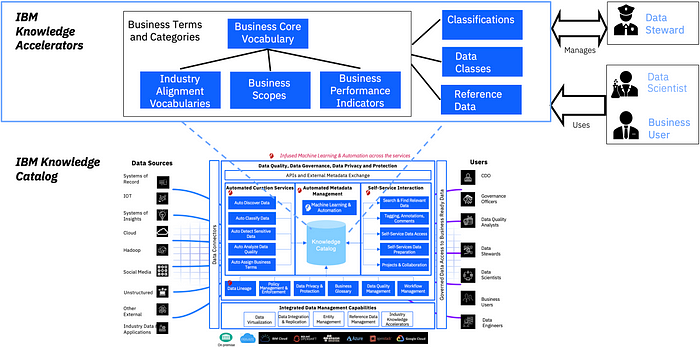
IBM Knowledge Accelerators (link for more details) are collections of industry-specific data governance artifacts, including categories, business terms, data classes, and reference data. These artifacts enable organizations to establish a solid business metadata framework for their industry. IBM provides these accelerators as part of WKC. The contents in these accelerators have a rich heritage, representing the well-known industry models previously used in IBM offerings, such as Information Framework (IFW), Insurance Application Architecture (IAA), and Banking and Financial Markets Data Warehouse (BFMDW). Many IBM clients have utilized these models to build their data warehouses, business processes, and service-oriented applications.
At the core, the Knowledge Accelerators are a set of interrelated business terms that describe the main concepts and associated properties specific to organizations in certain industries, such as banking and insurance.
Using BIAN to Define and Organize Data Governance Artifacts
The BIAN framework brings a common business language for both business and data practitioners in describing and modeling business capabilities and the data that support those capabilities. In the following sections, we show:
- BIAN Service Landscape for defining the category hierarchy for organizing data governance artifacts
- BIAN Service Domains as business terms for describing the business service components the data assets support
- How to combine the BIAN-based business terms and the lower-level artifacts from the industry accelerators
Organizations can start with the enterprise blueprint (Figure 2) derived from the BIAN Service Landscape or the business capability view similar to the BIAN BCM (Figure 3). We use the Service Landscape to define and organize the data governance artifacts for the work described in this article. The main reason is that the business service component view is essential to adopting cloud-native and microservices architecture that takes advantage of container platforms such as Kubernetes and Red Hat OpenShift. In this new architecture, the business service components supporting multiple higher-level business capabilities directly own the underlying data assets. An organization starting with a business capability view will likely define a complementary business service component view as they move to implementation, applying such an approach as domain-driven design (DDD). [Read this article to learn more about applying BIAN to DDD.]
BIAN Service Landscape for Category Hierarchy
We use the structure in the BIAN Service Landscape to model the category hierarchy for WKC with Service Landscape “Service Landscape — Value Chain” at the top, Business Areas such as “Products” at the next level, Business Domains such as “Consumer Banking” at the next level, and the Service Domains such as “Current Account” as business terms. We also use tags to represent the Business Areas, Business Domains, and Service Domains. These tags help search and filter to find the right data governance artifacts. Figure 5 shows the mapping of constructs in the BIAN Service Landscape (left side) to the governance artifacts, such as categories, business terms, and tags (right side).

Figure 6 is a screenshot illustrating the hierarchy of Service Landscape, Business Areas, and Business Domains represented as categories (left side) and Service Domains defined as business terms (right side) in WKC.
The definitions of the categories and business terms representing the overall BIAN Service Landscape, in terms of WKC import files, are available for download here.

BIAN Service Domains as Business Terms for Mapping Data Assets
Data assets such as databases or tables are mapped to the business terms representing the business service component defined by the corresponding Service Domains. Figure 7 shows a table “CUST_INFO” mapping to the business term “Party Reference Data Directory”.
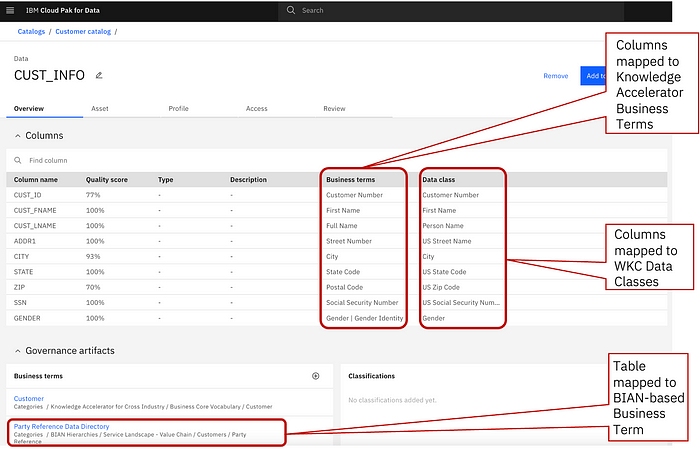
Notice that we stopped at the Service Domain level for the work above. While it’s entirely possible to elaborate on the business terms at the BIAN Service Domain level to define additional lower attribute level artifacts using BIAN reference models (Control Records, Behaviour Qualifiers, and the related Business Object Models), doing so would require a lot of additional effort and has a dependency on BIAN reference models that are still evolving rapidly. On the other hand, we could take advantage of the existing industry accelerators, such as the Knowledge Accelerators, which contain the detailed attribution of industry concepts that enable the auto-assignment of columns to business terms and data classes during the metadata enrichment process of data cataloging.
Combining Two Complementary Sets of Governance Artifacts
The example in Figure 7 above shows the mapping of the same data asset to two separate sets of artifacts, one BIAN-based for mapping the data table to the business service component “Party Reference Data Directory” (business term), the other for mapping the table columns to lower level artifacts such as “Social Security Number” (business term) and “US Social Security Number” (data class) defined in the Knowledge Accelerators.
How to combine these two separate but complementary sets of artifacts Conceptually, each Service Domain (defined as a business term) has its internal attributes (Control Record, Behaviour Qualifiers, and their attributes) that can be mapped to the relevant lower-level business terms and data classes defined in the Knowledge Accelerators. As an example, Figure 8 below shows in WKC, the definition of the BIAN-based business term “Party Reference Data Directory” includes artifacts from the Knowledge Accelerators, such as business terms “First Name”, “Last Name”, and “Social Security Number” under the “Has a part of” section and data classes “First Name”, “Last Name”, and “US Social Security Number” under the “Data classes” section. The above is only an example of connecting the two sets of artifacts. More extensive work, potentially leveraging related AI capabilities, would be required to fully establish these connections for all BIAN-based business terms.
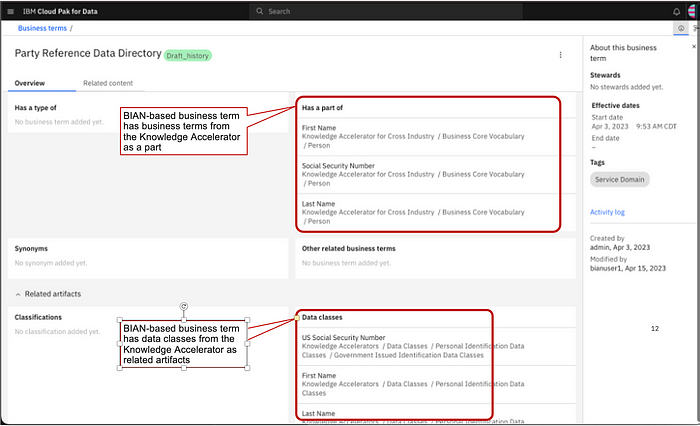
Summary
In this article, we explored using BIAN as the business component framework for data governance. We used BIAN Service Landscape as a component business framework to define the category hierarchy to organize data governance artifacts. We defined BIAN Service Domains as business terms that map data assets to the business service components they support. We also showed how to combine two different but complementary perspectives by extending a BIAN-based business term with related lower-level artifacts from the Knowledge Accelerators.
References
[1] BIAN reference model version 11.0 https://bian.org/servicelandscape-11-0-0/
[2] BIAN Business Capability Model — Statement of Alignment with the BIAN Service Landscape, to be published
[3] IBM Watson Knowledge Catalog https://www.ibm.com/cloud/watson-knowledge-catalog
[4] IBM Knowledge Accelerators https://www.ibm.com/cloud/knowledge-accelerators
[5] Data governance artifacts (categories and business terms) representing the BIAN Service Landscape, as WKC import files https://github.com/biaohao/bian-for-data-governance
